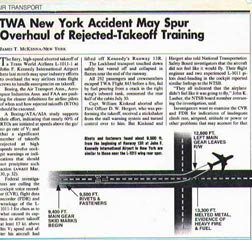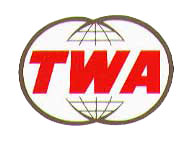
Investigation

8 months Later
Flight 843: at the highest point of lift-off, the nose was 25 feet from the ground and the tail section was 14 feet from the ground.It would take the National Transportation Safety Board almost 8 months to determine if the crash of Flight 843 was a crash landing or take-off. The NTSB concluded it was a crash landing. And, as usual, Human error is always a favorite with the NTSB. TWA and ALPA strongly disagreed with the NTSB's conclusion and stood behind their crew. Additionally the NTSB refused to acknowledge flight 843 was on fire BEFORE leaving the runway. This determination was made in spite of the fact that the Flight Attendants and passengers stated they saw fire prior to lift off. The NTSB felt that the passengers and crew must have been confused.
So what did happen?
A false stall warning of the stickshaker occurred just as the plane was to lift off. Playback from the black box in the cockpit showed that there was a debate between the Captain, First Officer and the Flight Engineer. The Flight Engineer said his instruments showed all was well. The First Officer believed the airplane was about to stall so he turned the control over to the Captain. Captain Kinkead had less than 6 seconds to make a lifetime decision - and decided to reject the takeoff by reducing the engine thrust. His decision was based, in part, on the perception of available runway to stop the airplane. Captain Kinkead wrote a letter to the NTSB stating; "I positively did not believe it would fly". Captain Kinkead knew that there was plenty of open field at the end of the runway and if necessary could evacuate there.The NTSB did agree design deficiencies of the stall warning system permitted a defect to go undetected. The aircrafts logbook recorded that this particular stick shaker had been written up several times earlier. The aircraft’s log book July 6 contained a report of a possible fuel leak on the underside of the right wing. It was concluded at the time that the fuel was probably lubricant oil. July 8 the logbook contained a report that the stickshaker had activated "for no apparent reason". Conclusions on the stickshaker later determined it was actually the fault of a pin which would vibrate loose.
Return to topOff the Record
On July 30, during the mandatory "walk-around" before departure, TWA mechanics did notice a small fuel leak near the right main landing gear. They looked for the source, but did not find anything conclusive.After the crash, at the point of rotation, TWA mechanics found an excessive amount of fuel on the runway. And the trail of jet fuel continued down the runway . So why didn't the NTSB see this fuel spill? On July 31, a freak thunderstorm hit Kennedy airport and washed away all evidence of a possible fuel leak. No trail, no story.
A piece of the right wing spar was found on the runway before the airplane left the ground. A photograph surfaced later on to back up the findings. NTSB was not interested in the photograph. In fact, a member of the investigation group picked up the piece of wing spar and loaded it into the back of a vehicle without numbering or marking the exact position ( as told to me later on by one of our own mechanics). The crack in the wing spar was approximately 3 - 4 feet long, with an 8 inch gash. And the broken portion of the wing spar was directly over the right main landing gear.
Return to topHysteria, hardly!
Regarding "confused passengers and Flight Attendants", as to whether the plane was on fire before or after lift off - this will forever be debated. Flight Attendants seated in the rear of the aircraft said the plane was on fire BEFORE lift-off. Passengers were standing in the aisle just as the plane left the ground - why? They could see the flames covering the passengers window. Fire before lift-off did not fit the guidelines established by the NTSB and FAA. The rules are: once committed to takeoff and the aircraft has reached lift off speed, the plane must follow through with the takeoff and then circle the tower for evaluation. This never would have worked. The plane was on fire. To circle the tower, return to the runway and land would have meant dumping extra fuel. Regardless of the stickshaker and stall warning - takeoff under any circumstances would have been certain death for all.Hysterical Flight Attendants - really? When interviewed later, Paula Guise-Williams, (Flight Attendant seated at the #4 door, right side of the tail section) was asked, “how high off of the ground was the plane?” She calmly replied; "I know it was exactly 14 feet". And was it? Absolutely! Hysterical - we think not!
The control tower did manage to warn the cockpit that there were flames shooting out from the aft section of the aircraft. The towers report coincided with the same time the plane began to lift off . And at the same moment the cockpit received a fire alarm warning from the #2 engine. The pilots were aware of fire, but never dreamed it was extensive to engulf the entire aft section of the aircraft.
Return to topWeather
The weather played a very interesting role in the crash. It was a perfect day. No wind, no clouds - just blue blue sky. It was neither warm nor cold - simply perfect. But - had Flight 843 been able to stop in the middle of the runway, with the tail section engulfed in flames - the possibility of everyone evacuating safely was unlikely. Fire always travels to the highest point, which means the fire would have enveloped the fuselage. But because the nose gear did collapsed - the highest point was where the #2 engine was positioned - top of the tail. Thus the fire and smoke kept to the rear of the plane followed the upward angle to the engine and allowed the passengers to run forward "down hill" to the front emergency exits. The passengers evacuated out two main forward emergency doors. The slides acted more like a ramp than slides, thus keeping injuries to a minimum.
Return to topComments
The conclusions from the NTSB were disappointing. But TWA never faltered;"Our pilots did everything right". Any doubts - just ask 273 passengers.
Return to topAbout this particular TWA L1011
This L1011 was #2 in the TWA fleet. Only recently had this L1011 returned to TWA service.The plane had been leased to a charter operation out of Boston. Common with charter airlines, they do minimum maintenance on aircraft. Lockheed sent out a bulletin regarding the wing spar modification. TWA mechanics promptly modified all of the TWA L1011 fleet except those on lease to Charter operations. This particular aircraft had yet to be modified. Charter Airlines operations are less than kind to their equipment and this plane was a good example. It is important to understand that #11002 aircraft was scheduled for complete a overhaul in just a few days.


